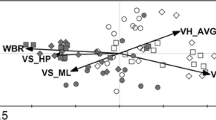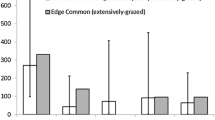Abstract
The effect of habitat fragmentation on spatial foraging behaviour in the root vole Microtus oeconomus was investigated in seven experimental populations. Four of the populations were established in large, continuous blocks (30 × 95 m) of meadow habitat (treatment plots), whereas the three remaining populations had six small rectangular habitat fragments (30 × 7.5 m) with variable inter-fragment distances (control plots). Both the small habitat fragments and the large continuous habitat were embedded in a non-habitat matrix area which was regularly mowed. Half-way through the study period, the continuous habitat in treatment plots was destroyed by mowing to give a configuration identical to the control plots. Dyed bait placed at the edges and in the interior of habitat fragments as well as in the matrix area was used to reveal differential use of these areas for foraging. Animals in the small-fragment plots fed more than expected along the edges, while edges were used according to availability in the large blocks of continuous habitat. In the fragmented plots, the frequency of foraging in the matrix decreased with increasing distance to the fragment border and with increasing inter-fragment distances. Furthermore, the frequency of use of more than one habitat fragment in individual foraging ranges decreased with increasing inter-fragment distances. Reproductively inactive animals of both sexes fed more often along habitat edges than reproductively active animals. Reproductively active females fed exclusively in one habitat fragment, whereas inactive animals and especially reproductively active males frequently included more than one fragment in their foraging ranges. The only effect of habitat destruction was less foraging in the matrix habitat in the post-destruction treatment plots compared to the permanently fragmented control plots. This was probably an effect of different matrix quality. Root voles in these experimental populations forage in edge and matrix habitat with great risk of becoming victims to predation, and the results are interpreted in this context.
Similar content being viewed by others
Author information
Authors and Affiliations
Additional information
Received: 19 August 1998 / Accepted: 30 June 1999
Rights and permissions
About this article
Cite this article
Hovland, N., Andreassen, H. & Ims, R. Foraging behaviour of the root vole Microtus oeconomus in fragmented habitats. Oecologia 121, 236–244 (1999). https://doi.org/10.1007/s004420050925
Issue Date:
DOI: https://doi.org/10.1007/s004420050925




